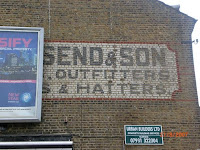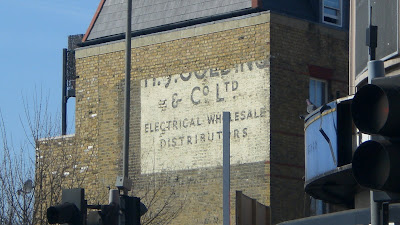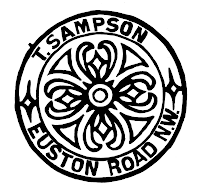The background - I may not have done Surbiton the justice it deserves. A Saturday or two ago AFC Wimbledon were taking on the dark powers of Welling United and for various reasons I found myself at the ground a few hours early. Not a problem, I remembered that Surbiton was only down the road from Kingston so I set off for a nice stroll in the sunshine. Unfortunately it was a little further than I thought, about a 5 mile round trip so by the time I got there I had to think about getting back again pretty quick! There was only time for a swift stroll down the High Street and down to Brighton Road before retracing my steps back to the game.
Victoria Road: This has the look of an old municipal library about it and it's easy to let the eye slide over its richly ornamented surface. It's well worth a closer look though. It's the sort of fascia we'd swoon over if it was in a French village but as it's in London I suspect we tend to devalue it.
 Victoria Road: Some modern municipal art here which would have been better if I could have fitted both panels in their entirity. I didn't fancy trying to take a photo stepping off the pavement and backing into the traffic though so I opted for the more artistic 'random section of mural ' approach. Presumably it's a celebration of all things Surbiton, although most of it seems to consist of trains and trams...
Victoria Road: Some modern municipal art here which would have been better if I could have fitted both panels in their entirity. I didn't fancy trying to take a photo stepping off the pavement and backing into the traffic though so I opted for the more artistic 'random section of mural ' approach. Presumably it's a celebration of all things Surbiton, although most of it seems to consist of trains and trams... Seething Wells gets a mention though. I always thought it was the name of a ranting punk dub-poet but actually seems to be a water treatment works by the Thames.
Seething Wells gets a mention though. I always thought it was the name of a ranting punk dub-poet but actually seems to be a water treatment works by the Thames. Brighton Road: Right at the end of my stroll was an intriguing remnant of a corner sign. A single letter 'D' is all that remains of ....something. A close look might reveal some clues from the shading left.
Brighton Road: Right at the end of my stroll was an intriguing remnant of a corner sign. A single letter 'D' is all that remains of ....something. A close look might reveal some clues from the shading left. Corner of Brighton Road & Victoria Avenue: There's an interesting tower on the corner of these roads that has an elaborate piece of ironwork at its top. I've zoomed in as close as I could and it seems to have the worlds smallest weather vane on the top. I could hardly make it out with my little zoom lens so I can't imagine that it would have been of any use to the average passerby.
Corner of Brighton Road & Victoria Avenue: There's an interesting tower on the corner of these roads that has an elaborate piece of ironwork at its top. I've zoomed in as close as I could and it seems to have the worlds smallest weather vane on the top. I could hardly make it out with my little zoom lens so I can't imagine that it would have been of any use to the average passerby. Victoria Road: I spotted this plate on the main road and it is obviously directions to a hydrant of some sort. These are usually water hydrants but I'm not sure what the SC refers to.Whatever it is it seems to be 3? ft away. I've also looked at the picture as closely as I can and I still can't make out what the ? is!
Victoria Road: I spotted this plate on the main road and it is obviously directions to a hydrant of some sort. These are usually water hydrants but I'm not sure what the SC refers to.Whatever it is it seems to be 3? ft away. I've also looked at the picture as closely as I can and I still can't make out what the ? is! Brighton Road: This ghost sign is now almost illegible and on the side of a building that as you can see not at all shop-like.You can just make out the words LADIES TAILOR though...
Brighton Road: This ghost sign is now almost illegible and on the side of a building that as you can see not at all shop-like.You can just make out the words LADIES TAILOR though... "... And Fancy Goods" is also on the front of the same building. I can't see what's to the left of the window though.
"... And Fancy Goods" is also on the front of the same building. I can't see what's to the left of the window though. Victoria Road: There's an attractive and large building on the junction of Brighton Road and Victoria Road. It's now divided into separate shops but it was obviously originally built as a single unit.Almost all of the columns are painted but one owner has taken the trouble to remove the paint to reveal some really intriguing and attractive green marble. As usual the original is so much more interesting than the current version that I find myself wondering how the painters felt covering it up for the first time.
Victoria Road: There's an attractive and large building on the junction of Brighton Road and Victoria Road. It's now divided into separate shops but it was obviously originally built as a single unit.Almost all of the columns are painted but one owner has taken the trouble to remove the paint to reveal some really intriguing and attractive green marble. As usual the original is so much more interesting than the current version that I find myself wondering how the painters felt covering it up for the first time. Victoria Road: "Stuarts (?) Your 'Do it Yourself Flooring Centre" A great example of the need to always look over your shoulder.I hadn't seen this when going down Victoria Road but when you turn around and head for home you really can't miss it. I'm pretty sure it says 'Stuarts' and I'd assume it was originally in a lighter colour such as red which has faded over time much quicker than the black. It's also slightly strange to see 'Do it Yourself' rather than DIY. It almost comes across as a snapy retort or even an order rather than as a positive lifestyle suggestion.
Victoria Road: "Stuarts (?) Your 'Do it Yourself Flooring Centre" A great example of the need to always look over your shoulder.I hadn't seen this when going down Victoria Road but when you turn around and head for home you really can't miss it. I'm pretty sure it says 'Stuarts' and I'd assume it was originally in a lighter colour such as red which has faded over time much quicker than the black. It's also slightly strange to see 'Do it Yourself' rather than DIY. It almost comes across as a snapy retort or even an order rather than as a positive lifestyle suggestion. Victoria Road: "Jones & Hommersham - London" Luckily I wasn't just looking up, I was also keeping my eyes on the ground (although not at the same time, obviously) My next little gem was a local coalhole with a name new to me and an attractive compass-point design. This and the Stuart ghost sign really made the trip worthwhile. (nb Some quick checks reveal that the more familiar use of company name was Homersham & Jones.That's with one 'M' in the Homersham and with Jones coming second.There are various leases etc.at the National Archive but this one seems pretty representative
Victoria Road: "Jones & Hommersham - London" Luckily I wasn't just looking up, I was also keeping my eyes on the ground (although not at the same time, obviously) My next little gem was a local coalhole with a name new to me and an attractive compass-point design. This and the Stuart ghost sign really made the trip worthwhile. (nb Some quick checks reveal that the more familiar use of company name was Homersham & Jones.That's with one 'M' in the Homersham and with Jones coming second.There are various leases etc.at the National Archive but this one seems pretty representativeCounterpart lease of numbers 28, 30, 32 Clarence Street for 25 years KX88/2/26 1897
Contents:Elizabeth Sarah Jones of Lampeter, Mount Hermon Estate, Woking, widow, and Sophia Eleanor Homersham, wife of Alfred Wyeth Homersham of Ormsby House, Richmond Park Road, Kingston, ironmonger, to Alfred Wyeth Homersham
 Right next to the Jones and Hommersham coalhole was this unusual example of a grid coalhole. You might thing this looks more like a drain but it's position and size exactly mirrored the other coalhole and I've no doubt that's what it is. Very intriguing though.
Right next to the Jones and Hommersham coalhole was this unusual example of a grid coalhole. You might thing this looks more like a drain but it's position and size exactly mirrored the other coalhole and I've no doubt that's what it is. Very intriguing though. Apart from a couple of bricked up doors that I'm saving for a future 'Ghost Doors' posting, that was all I had time to record. However I'm sure that such a cursory examination doesn't do Surbiton justice. Like Arnie and McArthur I'll have to promise that one day "I'll be back!"
Apart from a couple of bricked up doors that I'm saving for a future 'Ghost Doors' posting, that was all I had time to record. However I'm sure that such a cursory examination doesn't do Surbiton justice. Like Arnie and McArthur I'll have to promise that one day "I'll be back!"And, just for the record, Wimbledon lost...




 Aha! Could this be another clue? Ventilation holes running underneath the lid. Could this be to help disperse any noxious fumes from the sewer below? But again a nice show of cast-iron decoration. Whatever it is there's obviously been a lot of thought gone into its design and decoration.
Aha! Could this be another clue? Ventilation holes running underneath the lid. Could this be to help disperse any noxious fumes from the sewer below? But again a nice show of cast-iron decoration. Whatever it is there's obviously been a lot of thought gone into its design and decoration.





































